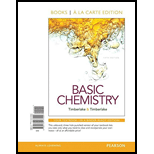
Concept explainers
(a)
Interpretation:
To whether the volume of container would increase or decrease in order to increase the yield of products.
Concept Introduction:
According to Boyle’s law, pressure and volume are inversely proportional to each other at constant temperature. Mathematically,
Gaseous molecules exert pressure on the wall of container as they are free to move within a container.
More the gaseous moles of compounds, more will be the pressure on the walls of container.
Le Chatelier’s principle = According to this principle, when an equilibrium mixture is disturbed by changing volume, pressure, amount of substances then equilibrium will shift in that direction where it can counteract the change to establish new equilibrium.
Effects on equilibrium on increasing volume:
Since volume is inversely proportional to pressure. Thus, increasing volume means decreasing the pressure. When an equilibrium system is disturbed by lowering the pressure, it will shift in that direction where the pressure will increase i.e. reaction will shift in that direction which has a greater number of gaseous moles.
Thus, when volume of container is increased then a gas-phase equilibrium will shift in the direction which has a greater number of gaseous moles.
Effects on equilibrium on decreasing volume:
Since volume is inversely proportional to pressure. Thus, decreasing volume means increasing the pressure. When an equilibrium system is disturbed by increasing the pressure, it will shift in that direction where the pressure will decrease i.e. reaction will shift in that direction which has a fewer number of gaseous moles.
Thus, when volume of container is decreased then a gas-phase equilibrium will shift in the direction which has a fewer number of gaseous moles.
(b)
Interpretation:
To whether the volume of container would increase or decrease in order to increase the yield of products.
According to Boyle’s law, pressure and volume are inversely proportional to each other at constant temperature. Mathematically,
Gaseous molecules exert pressure on the wall of container as they are free to move within a container.
More the gaseous moles of compounds, more will be the pressure on the walls of container.
Le Chatelier’s principle = According to this principle, when an equilibrium mixture is disturbed by changing volume, pressure, amount of substances then equilibrium will shift in that direction where it can counteract the change to establish new equilibrium.
Effects on equilibrium on increasing volume:
Since volume is inversely proportional to pressure. Thus, increasing volume means decreasing the pressure. When an equilibrium system is disturbed by lowering the pressure, it will shift in that direction where the pressure will increase i.e. reaction will shift in that direction which has a greater number of gaseous moles.
Thus, when volume of container is increased then a gas-phase equilibrium will shift in the direction which has a greater number of gaseous moles.
Effects on equilibrium on decreasing volume:
Since volume is inversely proportional to pressure. Thus, decreasing volume means increasing the pressure. When an equilibrium system is disturbed by increasing the pressure, it will shift in that direction where the pressure will decrease i.e. reaction will shift in that direction which has a fewer number of gaseous moles.
Thus, when volume of container is decreased then a gas-phase equilibrium will shift in the direction which has a fewer number of gaseous moles.
(c)
Interpretation:
To whether the volume of container would increase or decrease in order to increase the yield of products.
Concept Introduction:
According to Boyle’s law, pressure and volume are inversely proportional to each other at constant temperature. Mathematically,
Gaseous molecules exert pressure on the wall of container as they are free to move within a container.
More the gaseous moles of compounds, more will be the pressure on the walls of container.
Le Chatelier’s principle = According to this principle, when an equilibrium mixture is disturbed by changing volume, pressure, amount of substances then equilibrium will shift in that direction where it can counteract the change to establish new equilibrium.
Effects on equilibrium on increasing volume:
Since volume is inversely proportional to pressure. Thus, increasing volume means decreasing the pressure. When an equilibrium system is disturbed by lowering the pressure, it will shift in that direction where the pressure will increase i.e. reaction will shift in that direction which has a greater number of gaseous moles.
Thus, when volume of container is increased then a gas-phase equilibrium will shift in the direction which has a greater number of gaseous moles.
Effects on equilibrium on decreasing volume:
Since volume is inversely proportional to pressure. Thus, decreasing volume means increasing the pressure. When an equilibrium system is disturbed by increasing the pressure, it will shift in that direction where the pressure will decrease i.e. reaction will shift in that direction which has a fewer number of gaseous moles.
Thus, when volume of container is decreased then a gas-phase equilibrium will shift in the direction which has a fewer number of gaseous moles.
Want to see the full answer?
Check out a sample textbook solution
Chapter 13 Solutions
Basic Chemistry, Books a la Carte Edition (5th Edition)
 ChemistryChemistryISBN:9781305957404Author:Steven S. Zumdahl, Susan A. Zumdahl, Donald J. DeCostePublisher:Cengage Learning
ChemistryChemistryISBN:9781305957404Author:Steven S. Zumdahl, Susan A. Zumdahl, Donald J. DeCostePublisher:Cengage Learning ChemistryChemistryISBN:9781259911156Author:Raymond Chang Dr., Jason Overby ProfessorPublisher:McGraw-Hill Education
ChemistryChemistryISBN:9781259911156Author:Raymond Chang Dr., Jason Overby ProfessorPublisher:McGraw-Hill Education Principles of Instrumental AnalysisChemistryISBN:9781305577213Author:Douglas A. Skoog, F. James Holler, Stanley R. CrouchPublisher:Cengage Learning
Principles of Instrumental AnalysisChemistryISBN:9781305577213Author:Douglas A. Skoog, F. James Holler, Stanley R. CrouchPublisher:Cengage Learning Organic ChemistryChemistryISBN:9780078021558Author:Janice Gorzynski Smith Dr.Publisher:McGraw-Hill Education
Organic ChemistryChemistryISBN:9780078021558Author:Janice Gorzynski Smith Dr.Publisher:McGraw-Hill Education Chemistry: Principles and ReactionsChemistryISBN:9781305079373Author:William L. Masterton, Cecile N. HurleyPublisher:Cengage Learning
Chemistry: Principles and ReactionsChemistryISBN:9781305079373Author:William L. Masterton, Cecile N. HurleyPublisher:Cengage Learning Elementary Principles of Chemical Processes, Bind...ChemistryISBN:9781118431221Author:Richard M. Felder, Ronald W. Rousseau, Lisa G. BullardPublisher:WILEY
Elementary Principles of Chemical Processes, Bind...ChemistryISBN:9781118431221Author:Richard M. Felder, Ronald W. Rousseau, Lisa G. BullardPublisher:WILEY





